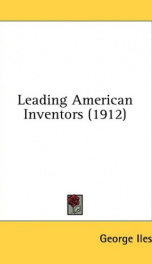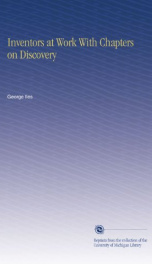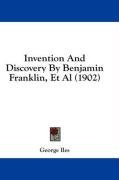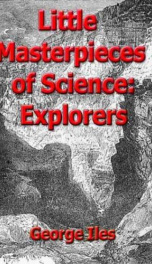leading american inventors

LEADING AMERICAN INVENTORS - 1912 - INTRODUCTORY - WITHIN its twelve chapters this book presents a group of leading American inventors of the past. First in time, and, in many respects, first in talent, is Colonel John Stevens, who built a successful screw propeller, and who devised a sectional boiler of a model which, duly modified, is in wide use to-day. Beside him stands his son Robert, who devised the T-rail and much other equipment for railroads and workshops. Fulton coines next with his Clermo. rzt and his torpedoes, an inventor with a statesmans breadth of mind, with the outlook of an artist no less than that of . an engineer. The mastery of land and sea is continued by Ericsson with his Novelty locomotive, his Monitor, and his caloric engine. These four great engineers are succeeded by four mechanics, each the leader of an industrial revolution. First Whitney, with his cotton-gin then Blanchard, with his copying lathe McCormick, with his reaper Howe, with his sewingmachine. Then, all alone, stands Charles Goodyear, who came to the vulcanization of rubber by dint of a courage unsurpassed in the annals of peace or war. A final quartette are . inventors who broadened the empire of the printed word Morse, who gave electricity a pencil to write its messages a thousand miles away Tilghman, who derived paper from wood so as to create a new basic industry for mankind Sholes, who built a typewriter to replace the pen . with the legibility and swiftness of printing and last of all, Mergenthaler, who took a Sholes keyboard, and bade it compose both the columns of newspapers and the pages of a book. The sketches of these heroes and their exploits include much information never published before. Inventors are apt to be a silent race, more given to experiment than to recording its results. We can retrace only a few of the steps which took such a man as Blanchard, for instance, from apprenticeship to primacy and triumph. Mergenthaler, fortunately, during months of rest and quiet as an invalid, wrote his autobiography. His son, Mr. Eugene G. Mergenthaler, has permitted several of its golden pages to appear in this volume. They picture the formative years of one of the great inventors of all time. Where opportunity has proffered itself, a contrast betwixt old and new, the days of small things and the present hour, is exhibited. Noteworthy here is the comparison of modern telegraphy with its puny beginnings, involving a struggle which all but overwhelmed Morse, the dauntless pioneer In preparing this book I have received n uchg enerous aid. The Stevens chapter owes many facts to President A. C. Humphreys and Professor F. de R. Furman of Stevens Institute, as well as to Mr. Edwin A. S. Brown of Hoboken. The pages on Eli Whitney are largely drawn from contributions by his grandson and namesake of New Haven, Connecticut. Mr. Edward Lind Morse of Stockbridge, Massachusetts, son of Professor Samuel F. B. Morse, has given me much information. Mr. James Cumming Vail of Morristown, New Jersey, sent me the portrait of his father printed in this volume, and has rendered me constant help. From Mr. S. M. Williams of the Western Union Telegraph Company, New York, came the statistics which round off the sketch of American telegraphy. The chapter on Charles Goodyear is mainly derived from his notebook, lent by his grandson, Mr. Nelson Goodyear of New York. Professor William H... --This text refers to the Paperback edition.
Info about the book
Author:
Series:
Unknown
ISBN:
0374409285
Rating:
4/5 (4)Your rating:
0/5
Languge:
English
Users who have this book
Users who want this book
What readers are saying
What do you think? Write your own comment on this book!
write a commentGenre
if you like leading american inventors try:
Do you want to read a book that interests you? It’s EASY!
Create an account and send a request for reading to other users on the Webpage of the book!







